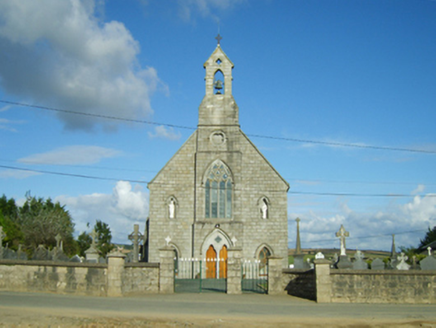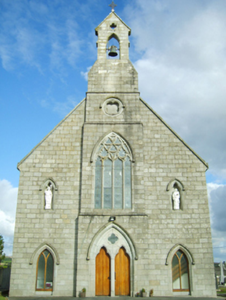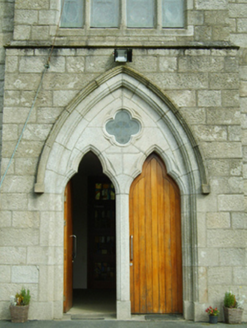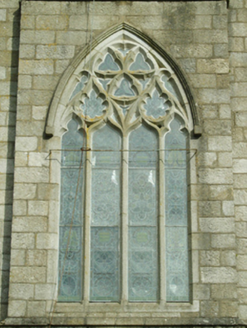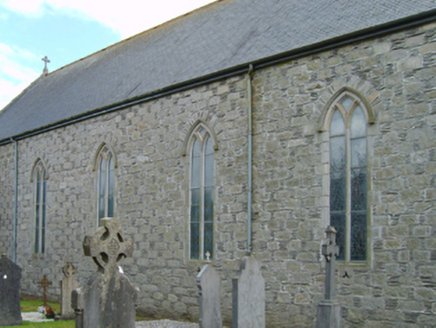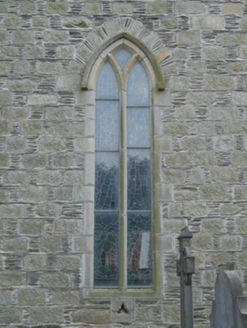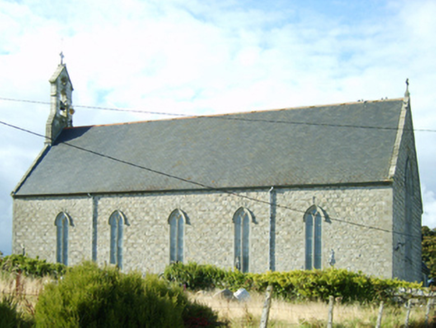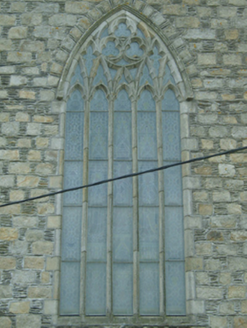Survey Data
Reg No
15701420
Rating
Regional
Categories of Special Interest
Architectural, Artistic, Historical, Social, Technical
Original Use
Church/chapel
In Use As
Church/chapel
Date
1860 - 1865
Coordinates
289494, 147210
Date Recorded
28/09/2007
Date Updated
--/--/--
Description
Detached five-bay double-height single-cell Catholic church, opened 1864, on a rectangular plan with single-bay full-height buttressed gabled breakfront to entrance (west) front. Reroofed, 1899. Renovated, 1969, with sanctuary reordered. "Restored", 1992. Damaged, 1997. Repaired, 1998. Pitched slate roof with roll moulded terracotta ridge tiles, cut-granite "slated" coping to gables on cut-granite "Cavetto" kneelers including cut-granite "slated" coping to gable to entrance (west) front on cut-granite "Cavetto" kneelers with quatrefoil-perforated granite ashlar buttressed gabled bellcote to apex framing cast-bronze bell, and cast-iron rainwater goods on timber eaves boards on exposed timber rafters retaining cast-iron downpipes. Part repointed tuck pointed schist-inserted coursed hammered granite battered walls with cut-granite flush quoins to corners; tuck pointed granite ashlar surface finish to entrance (west) front. Pointed-arch window openings with cut-granite Y-mullions, and cut-granite block-and-start surrounds having chamfered reveals with hood mouldings on monolithic label stops framing storm glazing over fixed-pane fittings having stained glass margins centred on lattice glazing bars. Trefoil-detailed pointed-arch window opening (east), cut-granite block-and-start surround having chamfered reveals with hood moulding on monolithic label stops framing storm glazing over fixed-pane fittings having leaded stained glass margins centred on leaded stained glass panels. Pointed-arch "Trumeau" door opening to entrance (west) front with cut-granite threshold, and cut-granite block-and-start surround having moulded reveals with hood moulding on monolithic label stops framing timber boarded doors. Pointed-arch window opening (gable), cut-granite block-and-start surround having chamfered reveals with hood moulding on monolithic label stops framing storm glazing over fixed-pane fittings having leaded stained glass margins centred on leaded stained glass panels. Pointed-arch door openings with cut-granite thresholds, and cut-granite block-and-start surrounds having chamfered reveals with hood mouldings on monolithic label stops framing replacement fixed-pane fittings. Interior including vestibule (west); square-headed door opening into nave with replacement glazed timber double doors having overlight; full-height interior open into roof with choir gallery on an engaged half-octagonal plan below stained glass "West Window" (1899), carpeted aisles between timber pews, paired timber stations between frosted glass windows, carpeted stepped dais to sanctuary (east) reordered, 1969, with arcaded communion table (1934) below stained glass memorial "East Window" (1913), and exposed Hammerbeam timber roof construction on cut-granite beaded corbels with timber boarded polygonal vaulted ceiling in carved timber frame on carved timber cornice. Set in landscaped grounds with granite ashlar piers to perimeter having flat iron Cross finial-topped pyramidal capping supporting crocketed wrought iron double gates.
Appraisal
A church erected under the aegis of Reverend John Dunne PP (----) representing an integral component of the mid nineteenth-century built heritage of County Wexford with the architectural value of the composition suggested by such attributes as the compact rectilinear "barn" plan form, aligned along a liturgically-correct axis; the construction in a silver-grey granite with schist inserts producing an eye-catching "chequerboard" pattern; the "pointed" profile of the openings underpinning a "medieval" Gothic theme with the chancel defined by a cusped "East Window"; and the handsome bellcote embellishing the roof as a picturesque eye-catcher in the landscape. Having been well maintained, the form and massing survive intact together with quantities of the original fabric, both to the exterior and to the interior reordered (1969) in accordance with the liturgical reforms sanctioned by the Second Ecumenical Council of the Vatican (1962-5) where a font 'brought from Templeshanbo Abbey' [SMR WX014-011001-]; contemporary joinery; the Nolan Memorial Window supplied (1931) by Earley Studios Limited (closed 1975) of Dublin to a design by William Earley (1872-1956); and the vibrant Jordan Memorial "East Window" (1913), all highlight the artistic potential of the composition: meanwhile, a complex roof construction 'using [an elaborate] tie beam system' (Craig and Garner 1975, 38) pinpoints the engineering or technical dexterity of a church forming part of a self-contained group alongside an adjacent parochial house (see 15701421) with the resulting ecclesiastical ensemble making a pleasing visual statement in a rural village setting.
